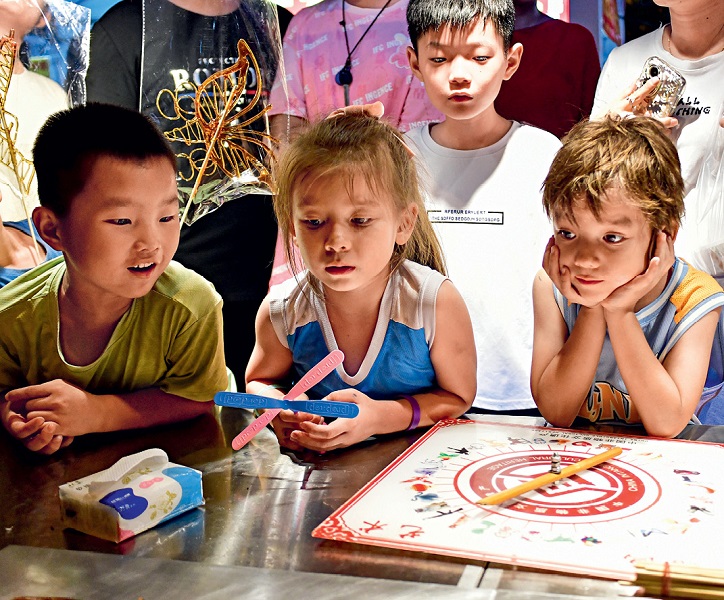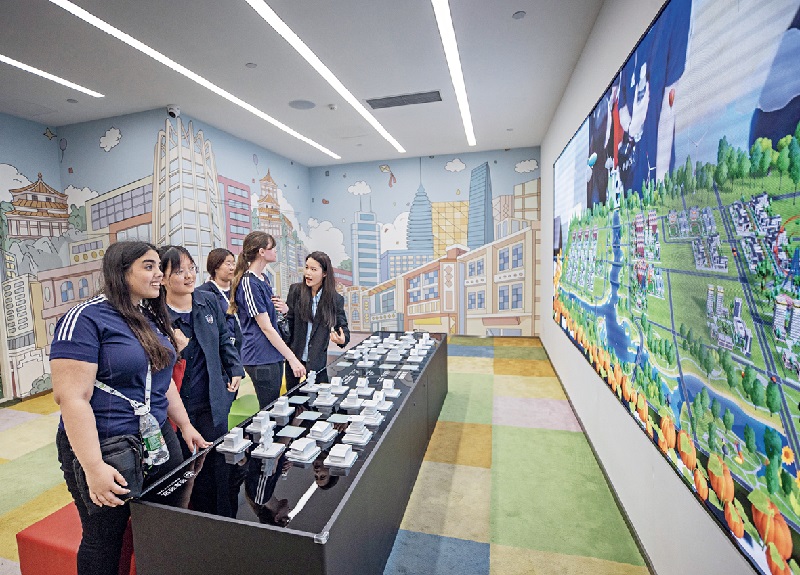Friendships which are derived from close contact between people of different countries hold the key to opening up sound state-to-state relations. Public diplomacy is an important part of a country’s overall diplomatic endeavors. It helps countries navigate across sensitive issues to improve international relations, enhance amity, and facilitate cooperation. As Chinese President Xi Jinping once said, “Friendship between peoples is a fundamental driving force for world peace and development, and an essential precondition for win-win cooperation.”
A prominent example of public diplomacy in recent history was the Ping-Pong diplomacy of 1972, which thawed Cold War tensions between the People’s Republic of China and the United States. That exchange between young people used as a key component of public diplomacy greatly benefited the personal growth of the participants, helped develop state-to-state relations, and enhanced people-to-people bonds between China and the U.S.
In his reply to a letter from students of a Hungarian-Chinese bilingual school in Hungary last year, President Xi Jinping encouraged Hungarian young people to learn more about China and become envoys of the China-Hungary friendship.
In January of this year, a delegation from the U.S. state of Utah made a cultural exchange-themed visit to Beijing and Shanghai, where they toured the Palace Museum and Fudan University. They were introduced to icons of traditional Chinese culture, such as chime bells, paper-cutting, and Peking Opera. During the same month, a group of students from Columbia University in the City of New York visited Beijing and Chengdu, where they were warmly received by local people. They were impressed by China’s long history and rich culture, as well as the vitality of the country’s economy and society.
In March, China invited 24 students from the Lincoln High School Tacoma and Steilacoom High School in Washington State to visit China under the Young Envoys Scholarship program.

Children attentively looking at an exhibition at the Yohood fair in Dongguan, Guangdong Province on October 14, 2023.
Personal Benefits
Participants in international exchanges always come away more enlightened, having broader horizons and enhanced cultural sensitivity. Because such activities often require the use of a foreign language, they also help young people improve their linguistic and communication skills.
As China’s economic strength continues to grow, it has built closer economic and trade ties with other countries. Mastering the Chinese language is now a big plus when a candidate applies for jobs at some multinationals. This has led to a stronger interest in learning Chinese around the globe.
At present, more than 180 countries have launched Chinese language education programs, 84 countries have incorporated Chinese language into their national education systems, and more than 4,000 universities have set up Chinese language departments, majors or courses. Tens of thousands of young people from more than 100 countries have been invited to China through programs such as the “Chinese Bridge” summer camp, and more can learn Chinese and experience Chinese culture through online activities.
When young people are away from their parents on international exchange programs, they become more independent and develop greater autonomy. In exchange tours, children are divided up into teams and must cooperate and interact with peers from different backgrounds, during which they develop interpersonal relationships and teamwork skills.
According to Madelyn Ross, president of the U.S.-China Education Trust, the trips of U.S. young people to China not only help them learn the Chinese language and culture, but also open up more opportunities for their future career development.
Fekete, who also goes by his Chinese name Ma Hongbo, studied at a Hungarian-Chinese bilingual school in Hungary before he was enrolled into the Yuanpei College of Peking University in Beijing. Studying at the bilingual school brought him more opportunities in later life, he said. He was grateful toward the Chinese teachers there, and hoped that he could follow their example in contributing to China-Hungary friendship in the future.
From January 3-12, 2024 a group of students from the Columbia University traveled to the Chinese cities of Beijing, Chengdu, and Shenzhen. In Chengdu, capital of Sichuan Province, they toured the Research Base of Giant Panda Breeding, the ancient irrigation system Dujiangyan, and the State Key Laboratory of Rail Transit Vehicle System run by the Southwest Jiaotong University. This experience gave these students a broad view of Chinese history, culture, economy, and society. William Simuku, of the Gen Z, said he and other members of the American delegation had extensive discussions with their Chinese peers, and gained a better understanding of each other in the process. He now had first-hand and profound knowledge about China.
Boosting China-West Relations
People-to-people exchanges are playing a significant role in promoting the healthy development of China-U.S. and China-Europe relations. There are differences between China and the West concerning values and ideology, which are often a source of misunderstanding and mistrust between them. People-to-people contact, including that between the youth, is conducive to building true friendship.
First, youth exchanges help enhance mutual understanding and friendships. By participating in exchange programs, young people can experience first-hand the culture, history, and social system of other countries. This enables them to better understand the differences and similarities that exist between them, build mutual understanding that helps reduce miscomprehensions and prejudices, and promote international peace and cooperation.
Second, international exchanges help young people foster an international vision and develop a broader mindset. By studying, living, and working with peers from different countries, young people can improve their cross-cultural communication and problem-solving skills. Participants in youth exchange programs today may become the driving force behind the development of China-U.S. and China-Europe relations tomorrow.
Third, youth exchanges also promote cooperation in other fields. During international exchanges, young people from different countries are able to establish long-term friendships, which results in facilitating cooperation and exchange in the fields of culture, education, science, and technology.
In January of this year, President Xi replied to a letter he received from Sarah Lande, a friend of his in the U.S. state of Iowa. In his reply, he announced a plan to invite 50,000 young people from the U.S. to China over the next five years, and expressed his hope that more American young people could come to see, hear, and experience life in China for themselves, so that they could have an accurate, multidimensional, and panoramic view of China, thus enabling them to serve as bridges of friendship between the two peoples.
In March this year, Beijing welcomed students from the U.S. and Germany. On March 17, 24 students from the Lincoln High School Tacoma and Steilacoom High School in Washington State arrived in the Chinese capital. From there they went on to Shiyan in Hubei Province and Guangzhou and Shenzhen in Guangdong Province. Yuti Thakore told the media she was thrilled to receive the invitation from President Xi, and shared the news with all her friends while counting the days to departure.
On March 28, Peng Liyuan, wife of President Xi Jinping, met with representatives of the students and teachers from the Chinese Choir of the Burg Gymnasium, a German high school, at Beijing No. 35 High School. Since its founding 10 years ago, the choir has inspired young Germans to learn about Chinese culture through singing in Chinese, and thereby enhanced the friendship between the two countries. One of its members Johanna said that in singing Chinese songs she improved pronunciation and tones, and got closer to Chinese culture. “When we sing together, the song, like a bridge, connects two languages and two culture. It is exciting,” she said.

U.S. Iowa State's Muscatine High School students and their Chinese peers from Shijia-zhuang Foreign Language School are learning about the urban planning for Xiongan, a city in China’s Hebei Province, on April 22, 2024.
Educational Cooperation
Cooperation and exchanges in education are critical for mutual learning and understanding among civilizations. Schools and educational programs jointly operated by China and other countries provide the youth convenient access to international education, facilitate the dissemination of knowledge, spur innovation in education, and promote exchanges of different cultures. Educational exchange programs bring young people together from different parts of the world, help them build bonds, and break down social misconceptions. As a result, a social foundation is laid for healthy relations between their countries of origin.
Educational cooperation is an important manifestation of China’s opening-up. With about 1.3 million Chinese studying abroad, China has become the world’s largest source of international students. It has also founded 1,500 institutions of learning with foreign partners. One of them is the Duke Kunshan University established in 2013 in the city of Kunshan in Jiangsu Province. As of January of 2024, the university has received applications for its undergraduate program from 4,705 students in 123 countries around the world, a year-on-year increase of 41 percent. About half of the applications come from the U.S. Dr. John Quelch, executive vice chancellor of the university, believes that more students from the U.S. and other countries will apply for universities in China as China and the U.S. intensify educational cooperation and exchanges.
Through studying, working, and traveling abroad, and participating in overseas programs, Chinese young people are pursuing deeper integration with the world and showing greater rationality, inclusiveness, self-confidence, and self-reliance to the world.
According to the Youth of China in the New Era, a whitepaper released by the Information Office of China’s State Council in April 2022, China sent just over 800 students abroad in 1978. In 2019, more than 700,000 Chinese students went abroad to pursue further education. Over the past four decades, the total number of Chinese people studying abroad has exceeded 6.5 million. The number of Chinese returning to China after finishing their study grew from 248 in 1978 to more than 580,000 in 2019, and their total number has exceeded 4.2 million over the past four decades and more.
Various types of youth exchanges in all forms are playing a key role in advancing communication and mutual learning among civilizations. They contribute to the personal growth of the individuals involved and also the amity between their countries. 
DR. LI GANG is associate researcher and Oujiang distinguished professor at Wenzhou University.